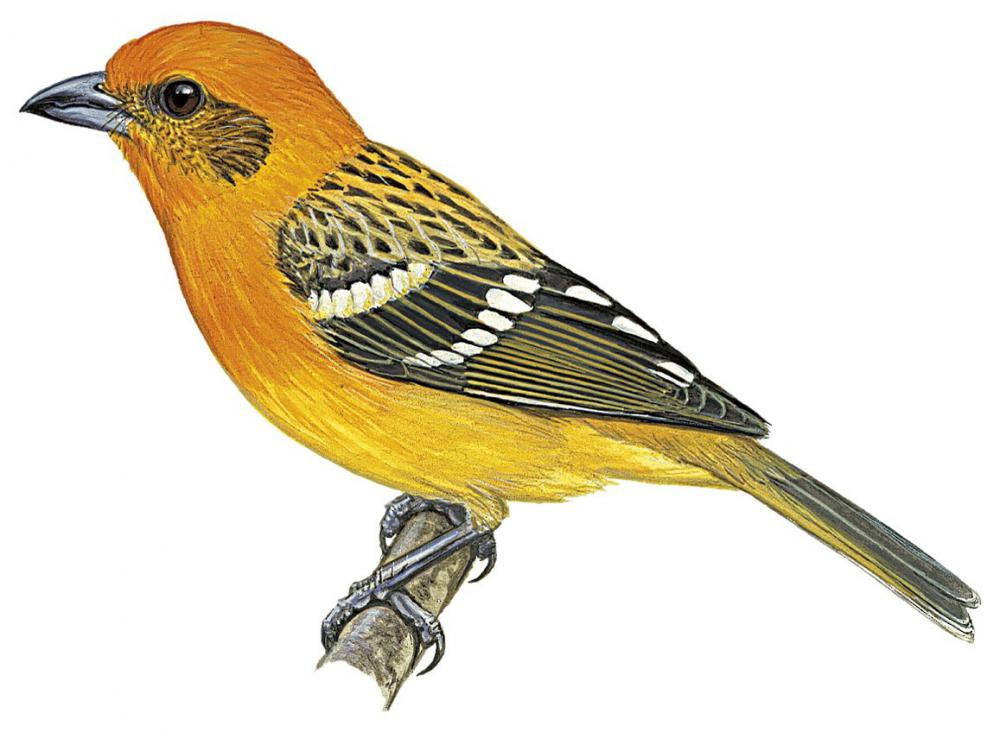Flame-colored Tanager / Piranga bidentata

Flame-colored Tanager
SCI Name:
Protonym: Pyranga bidentata Philos.Mag.n.s. n.s., 1 p.438
Taxonomy: Passeriformes / Cardinalidae / Piranga
Taxonomy Code: flctan
Type Locality: Temiscaltipec [, Mexico].
Author: Swainson
Publish Year: 1827
IUCN Status: Least Concern
DEFINITIONS
PIRANGA
(Cardinalidae; Ϯ Summer Tanager P. rubra) Güaraní name Pirangá red (bird), for a small bird, a finch or a tanager ("Πυρ, fire, (colour of the plumage)" (Ashmolean 1836)) (cf. “Tijepiranga” of Marcgrave 1648, a name for the Troupial Icterus); "No 12. Bec du Piranga incarnat, Piranga rubra. Cet oiseau que les auteurs ont rangé parmi les Tangaras, Tanagra Mississipensis, æstiva, LINN. GM., et d'autres parmi les Moucherolles, Muscicapa rubra, LINN. édit. 12, diffère assez des uns et des autres pour constituer un nouveau genre, dont le caractère principal est d'avoir le bec gros, alongé, droit, déprimé à sa base, convexe dessus et dessous, légèrement entaillé et recourbé à l'extrémité de sa partie supérieure." (Vieillot 1807); "Piranga Vieillot, 1808, Hist. Nat. Ois. Amér. Sept., 1 (1807), p. iv. Type, by monotypy, Muscicapa rubra Linnaeus, 1776 = Fringilla rubra Linnaeus, 1758." (Storer in Peters 1970, XIII, 301).
Var. Pyranga , Pynanga.
Synon. Diplochilus, Merula, Phoenisoma.
bidentata / bidentatus
Med. L. bidentatus having two teeth, double-toothed < L. bi- two- < bis twice; dentatus toothed < dens, dentis tooth; applied to spp. with two distinct notches on the upper mandible or maxilla.
● ex “Notched Falcon” of Latham 1787 (Harpagus).
SUBSPECIES
Flame-colored Tanager (bidentata)
SCI Name: Piranga bidentata bidentata
bidentata / bidentatus
Med. L. bidentatus having two teeth, double-toothed < L. bi- two- < bis twice; dentatus toothed < dens, dentis tooth; applied to spp. with two distinct notches on the upper mandible or maxilla.
● ex “Notched Falcon” of Latham 1787 (Harpagus).
Flame-colored Tanager (flammea)
SCI Name: Piranga bidentata flammea
flammea
L. flammeus flammulated, flame-coloured, fiery-red < flamma flame < flagrare to burn.
● "98. FRINGILLA. ... flammea. 20. F. fusca, crista flammea. Faun. svec. 201. Linaria s. Luteola nigra. Klein. av. 93. Habitat in Europa." (Linnaeus 1758) (Acanthis).
● ex “Aluco minor” of Willughby 1676, “Noctua guttata” of Frisch 1733, and Linnaeus 1746. “The name “flammea” first appears in the 12th edition of Linnaeus, and the description given by him certainly refers to the Barn-Owl and not to the Tawny Owl or Short-eared Owl, although the first reference - to no. 73 of the ‘Fauna Suecica’ - appears to refer to another bird, perhaps one of the two last-named. Linnaeus’s name Strix flammea is, however, invalidated by the use of the same name by Pontoppidan [1763] ...for the Short-eared Owl ...The Committee have decided that this is a case where the old and well-known name of “flammea” may well be conserved for the Barn-Owl and not transferred to the Short-eared Owl, as would be the case if the international rules of priority were followed out” (BOU 1915) (syn. Tyto alba).
Flame-colored Tanager (sanguinolenta)
SCI Name: Piranga bidentata sanguinolenta
sanguinolenta / sanguinolentum / sanguinolentus
L. sanguinolentus bloody < sanguis, sanguinis blood.
● ex “Sanguineous Creeper” of Latham 1801 (Myzomela).
Flame-colored Tanager (citrea)
SCI Name: Piranga bidentata citrea
citrea
L. citreus citrine < citrus citrus tree, citron.
● ex “Figuier à ventre et tête jaunes de la Louisiane” of d’Aubenton 1765-1781, pl. 704, fig. 2 (Protonotaria).
UPPERCASE: current genus
Uppercase first letter: generic synonym
● and ● See: generic homonyms
lowercase: species and subspecies
●: early names, variants, mispellings
‡: extinct
†: type species
Gr.: ancient Greek
L.: Latin
<: derived from
syn: synonym of
/: separates historical and modern geographic names
ex: based on
TL: type locality
OD: original diagnosis (genus) or original description (species)












